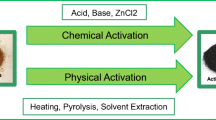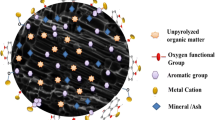Abstract
A biopreparation inducing oil destruction and increasing the biological activity of soils was developed on the basis of activated sludge. Its oxidative activity towards hydrocarbons was studied. The application of this biopreparation to oil-contaminated soil increased the population density of microorganisms, including destroyers of hydrocarbons, and accelerated oil decomposition. The degree of destruction of oil and oil products in the case of a single treatment of the soil with this biopreparation comprised 30 to 50% within 60 days. The presence of cellulose-decomposing microorganisms in this biopreparation also favored an accelerated decomposition of plant substances, including plant litter and sawdust applied to the urban soils as an adsorbent.
Similar content being viewed by others
References
O. A. Berestetskii, “Study of phytotoxic properties of microfungi,” in Manual on Experimental Mycology (Naukova Dumka, Kyiv, 1982), pp. 321–333.
V. V. Vel’kov, “Standardization of nomenclature of industrial technologies of bioremediation,” Biotekhnologiya, No. 2, 70–76 (2001).
I. M. Gabbasova, F. Kh. Khaziev, and R. R. Suleimanov, “Estimating the status of soils contaminated long ago by crude oil after biological remediation,” Eurasian Soil Sci. 35(10), 1116–1129 (2002).
E. A. Dmitriev, Mathematical Statistics in Soil Science (Izd. Mosk. Gos. Univ., Moscow, 1995) [in Russian].
A. A. Ivanov, N. V. Yudina, E. Y. Matis, E. V. Mal’tseva, and L. I. Svarovskaya, “Stimulation of the activity of microorganisms by humin preparations in oil-polluted soils,” Eurasian Soil Sci. 43(2), 210–215 (2010).
N. M. Ismailov and F. Askerov, “Experience in remediation of oil-contaminated soils in Azerbaijan,” Energy, Ecol., Econ., Nos. 1(8–9), 45–48 (2001).
N. M. Ismailov, V. I. Gadzhieva, and M. G. Gasanova, “Mineralization coefficient of hydrocarbons as an indicator of self-purification capacity of oil-polluted soils and efficiency of applied remediation measures,” Izv. Akad. Nauk AzSSR, Ser. Biol. Nauki, No. 6, 76–85 (1984).
N. A. Kireeva, V. V. Vodop’yanov, and A. M. Miftakhova, Biological Activity of Oil-Polluted Soils (Gilem, Ufa, 2001) [in Russian].
N. A. Kireeva, T. S. Onegova, and N. V. Zhdanova, “Study of possible implementation of belvitamil biopreparation for accelerating oil destruction in soils and water,” Biotekhnologiya, No. 5, 77–80 (2003).
S. V. Kerimov and N. M. Ismailov, “Ecological criteria for the choice of purification technologies of oil-polluted soils in the Apsheronskii Peninsula,” Azerb. Neft. Khoz., No. 3, 64–69 (2008).
S. I. Kolesnikov, K. Sh. Kazeev, and V. F. Val’kov, “Ecological functions of soils and the effect of contamination with heavy metals,” Eurasian Soil Sci. 35(12), 1335–1340 (2002).
S. I. Kolesnikov, K. Sh. Kazeev, M. L. Tatosyan, and V. F. Val’kov, “The effect of pollution with oil and oil products on the biological status of ordinary chernozems,” Eurasian Soil Sci. 39(5), 552–556 (2006).
V. M. Kondrashenko, et al., RF Patent 2191753, 2002.
M. F. Mir-Babaev, “Protection of the environment in the Caspian Sea,” Azerb. Neft. Khoz., No. 10, 77–80 (2010).
A. Kh. Mukatanov and P. R. Rivkin, “Influence of oil on soil properties,” Neft. Khoz., No. 4, 53–54 (1980).
T. D. Mukasheva and M. Kh. Shigaeva, “Biodegradation of Tengiz oil by local strains of microorganisms,” in Proceedings of the I International Congress “Biotechnology: Status and Prospective Development” (Moscow State University, Moscow, 2002).
A. Yu. Muratova, O. V. Turkovskaya, L. P. Antonyuk, O. E. Makarov, L. I. Pozdnyakova, and V. V. Ignatov, “Oil-oxidizing potential of associative rhizobacteria of the genus Azospirillum,” Microbiology (Moscow) 74(2), 210–215 (2005).
T. P. Pirog, I. N. Voloshina, and T. A. Shevchuk, “Implementation of haydite immobilized cells of oiloxidizing microorganisms for purification of water from trace oil concentrations,” in Proceedings of the II International Congress “Biotechnology: Status and Prospective Development” (Moscow State University, Moscow, 2003), Part 2, p. 36.
Practicum on Microbiology (Izd. Mosk. Gos. Univ., Moscow, 1976) [in Russian].
E. I. Novoselova, Doctoral Dissertation in Biology (Voronezh, 2008).
T. S. Onegova, Candidate’s Dissertation in Biology (Ufa, 2006).
Bergey’s Manual of Determinative Bacteriology (Williams & Wilkins, Baltimore, MD, 1994).
E. R. Rakhimova, A. V. Garusov, and S. K. Zaripova, “Biological activity of oil-contaminated soil upon its salinization,” Eurasian Soil Sci. 38(4), 425–428 (2005).
A. L. Stepanov, O. B. Tsvetnova, and S. N. Panikov, “Changes in the structure of the microbial community under the influence of oil and radioactive pollution,” Eurasian Soil Sci. 45(12), 1169–1173 (2012).
N. N. Tereshchenko, et al., “Ecological and biological aspects of the application of semifluid activated sludge for purification of oil-polluted soils,” Zashch. Okruzh. Sredy Neftegazov. Komplekse, No. 3, 47–49 (2009).
L. I. Trubnikova, “Remediation of disturbed lands with the use of excessive activated sludge from oil refinery plants,” Bezop. Zhiznedeyat., No. 1, 7–12 (2004).
I. K. Khabirov, I. M. Gabbasova, and F. Kh. Khaziev, Sustainability of Soil Processes (Bashkir State Agrarian University, Ufa, 2001) [in Russian].
A. R. Oberbremer, G. Y. Muller-Hurting, and F. D. Wagner, “Effect of the addition of microbial surfactants on hydrocarbon degradation in a soil population in a stirred reactor,” Appl. Microbiol. Biothech. 32, 485–489 (1990).
Author information
Authors and Affiliations
Corresponding author
Additional information
Original Russian Text © M.P. Babaev, S.I. Nadzhafova, A.G. Ibragimov, 2015, published in Pochvovedenie, 2015, No. 7, pp. 887–894.
Rights and permissions
About this article
Cite this article
Babaev, M.P., Nadzhafova, S.I. & Ibragimov, A.G. Application of activated sludge to purify urban soils of Baku city from oil contamination. Eurasian Soil Sc. 48, 773–779 (2015). https://doi.org/10.1134/S1064229315070029
Received:
Published:
Issue Date:
DOI: https://doi.org/10.1134/S1064229315070029




